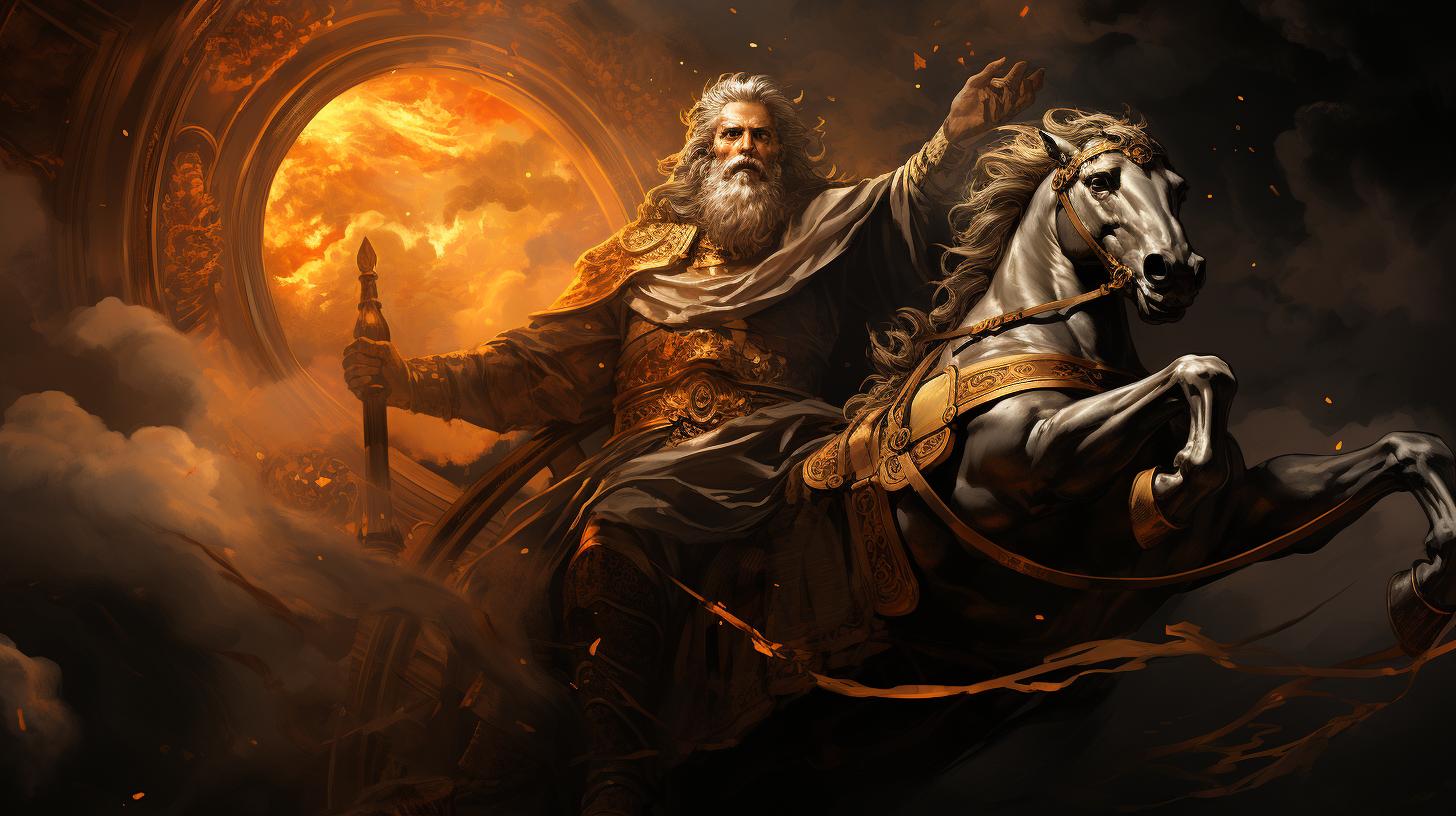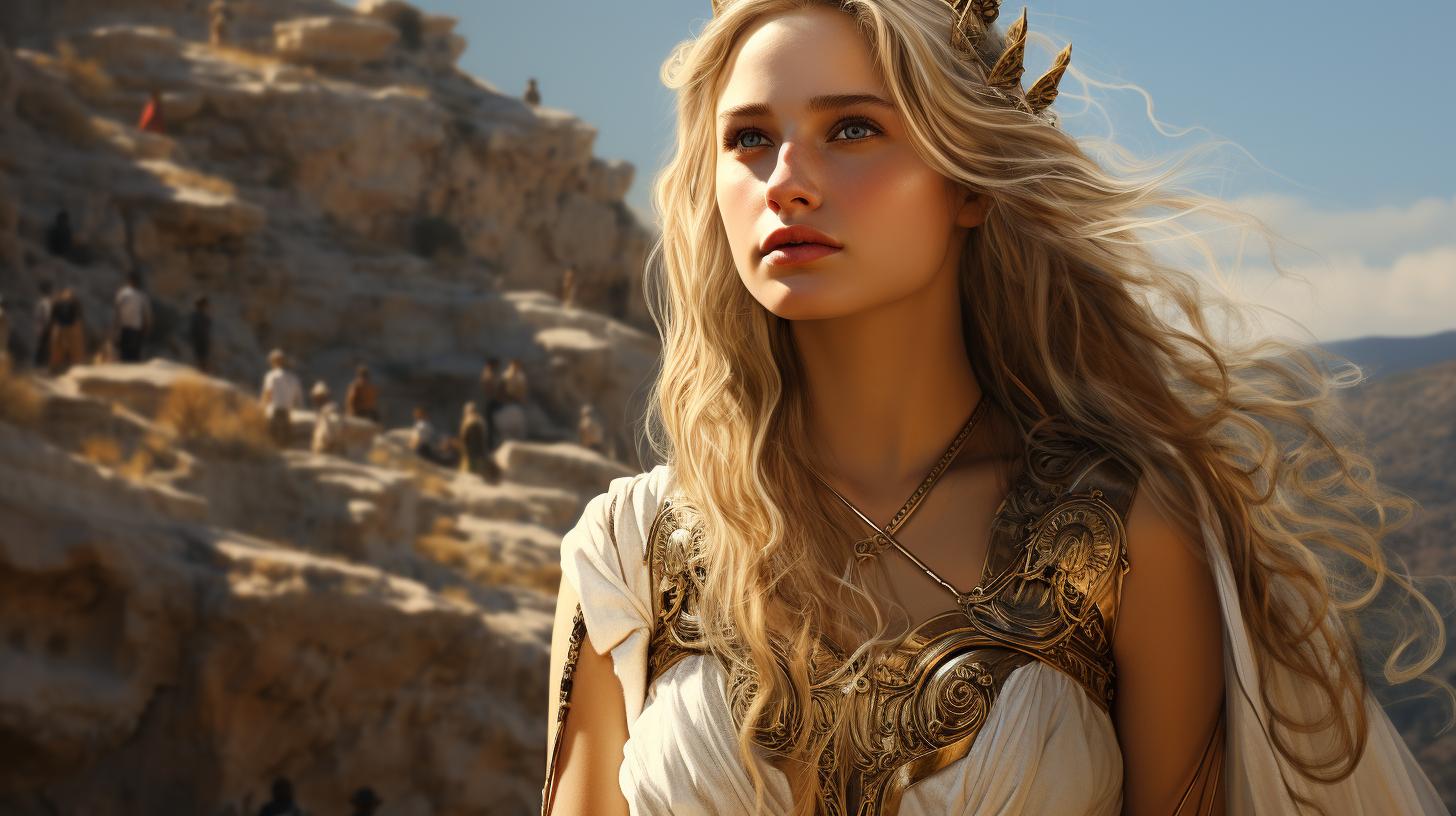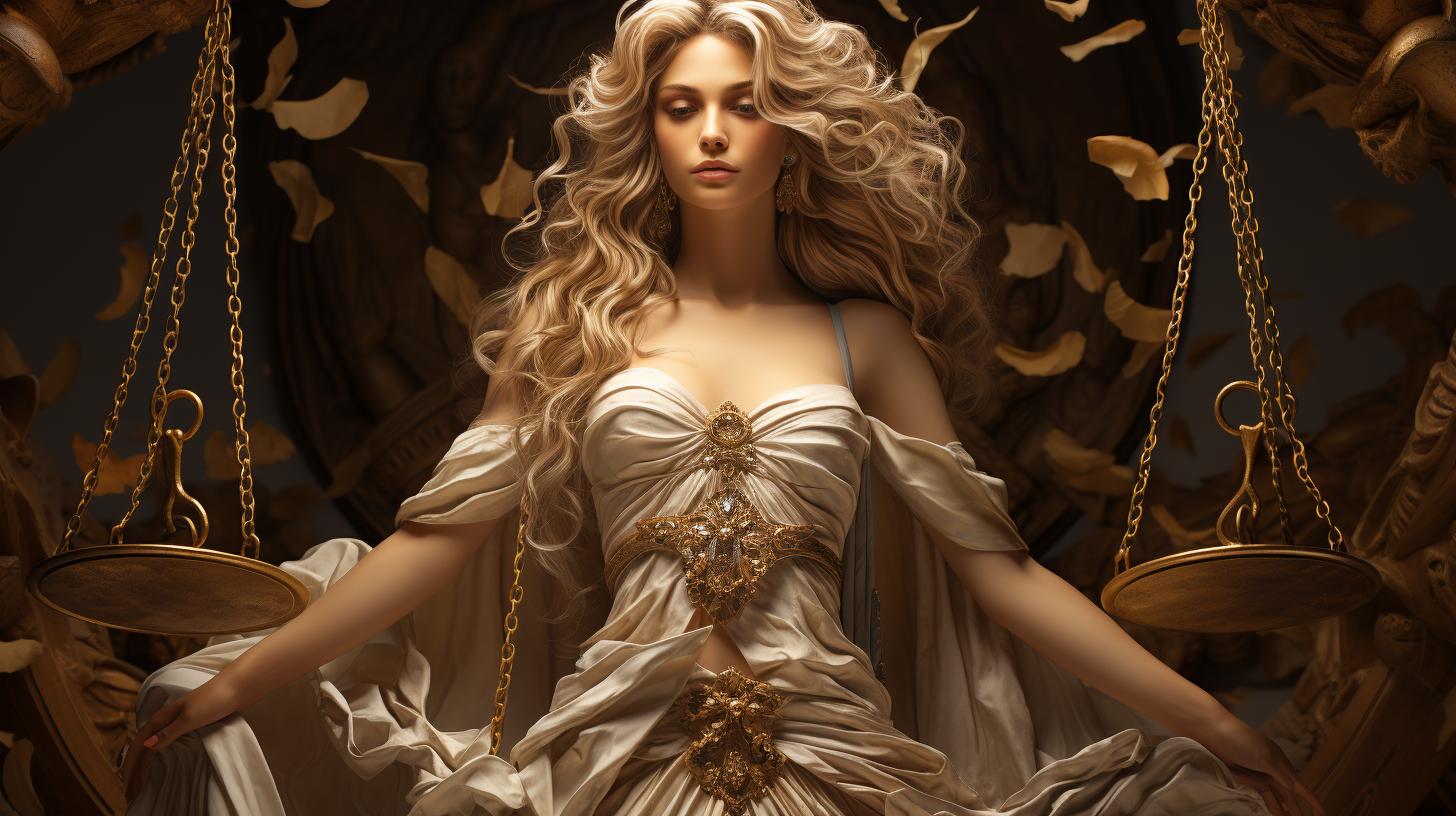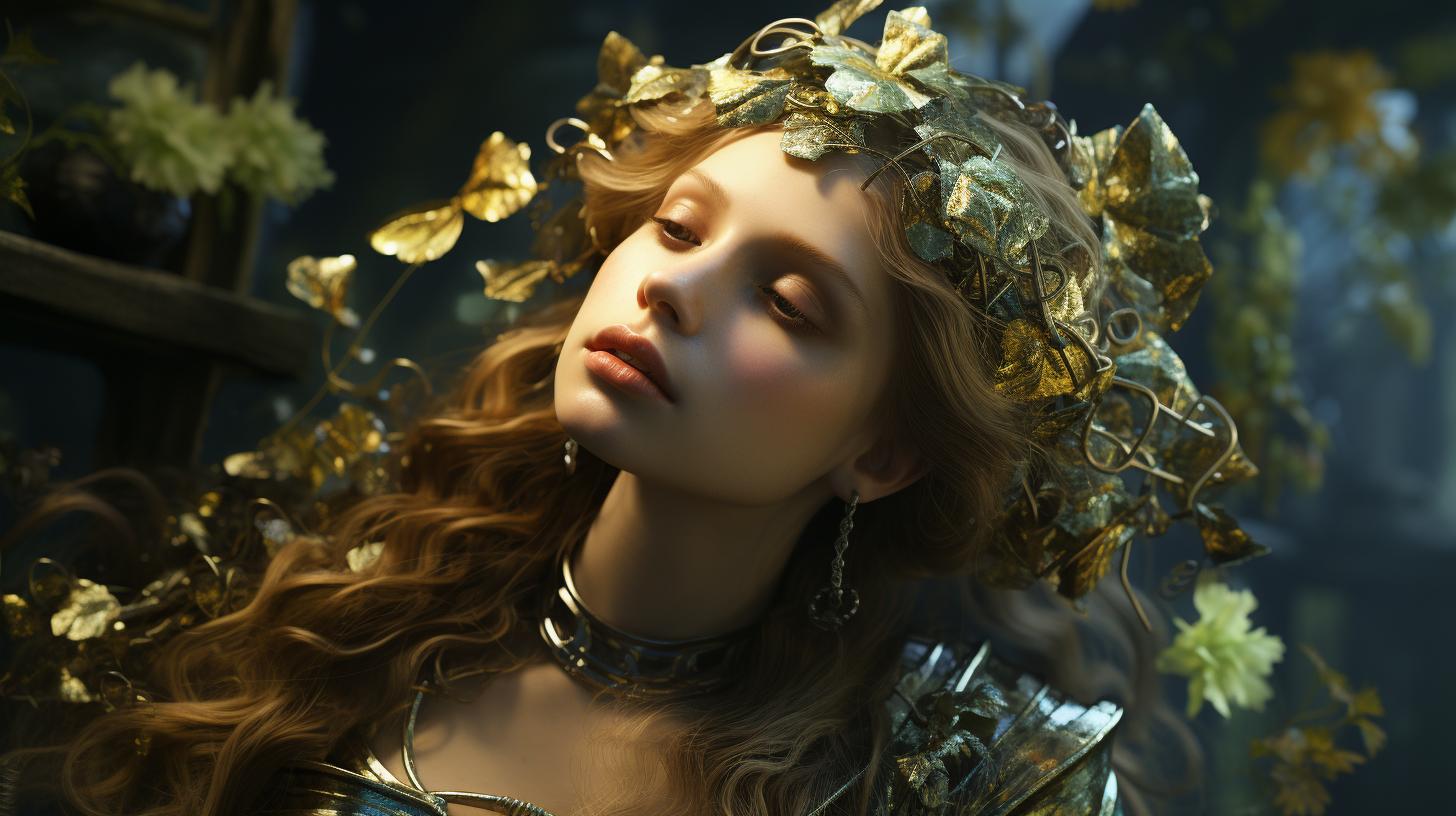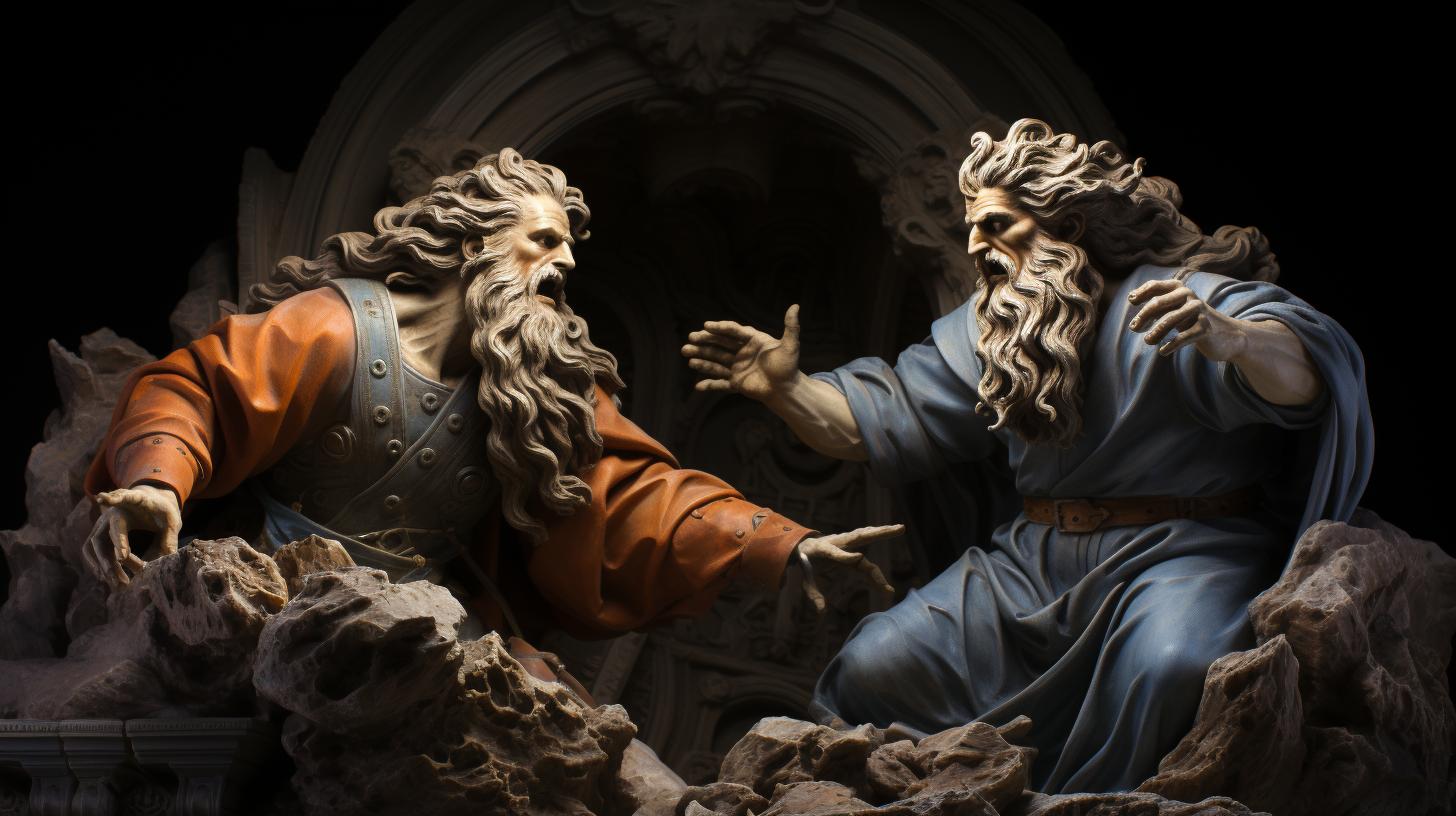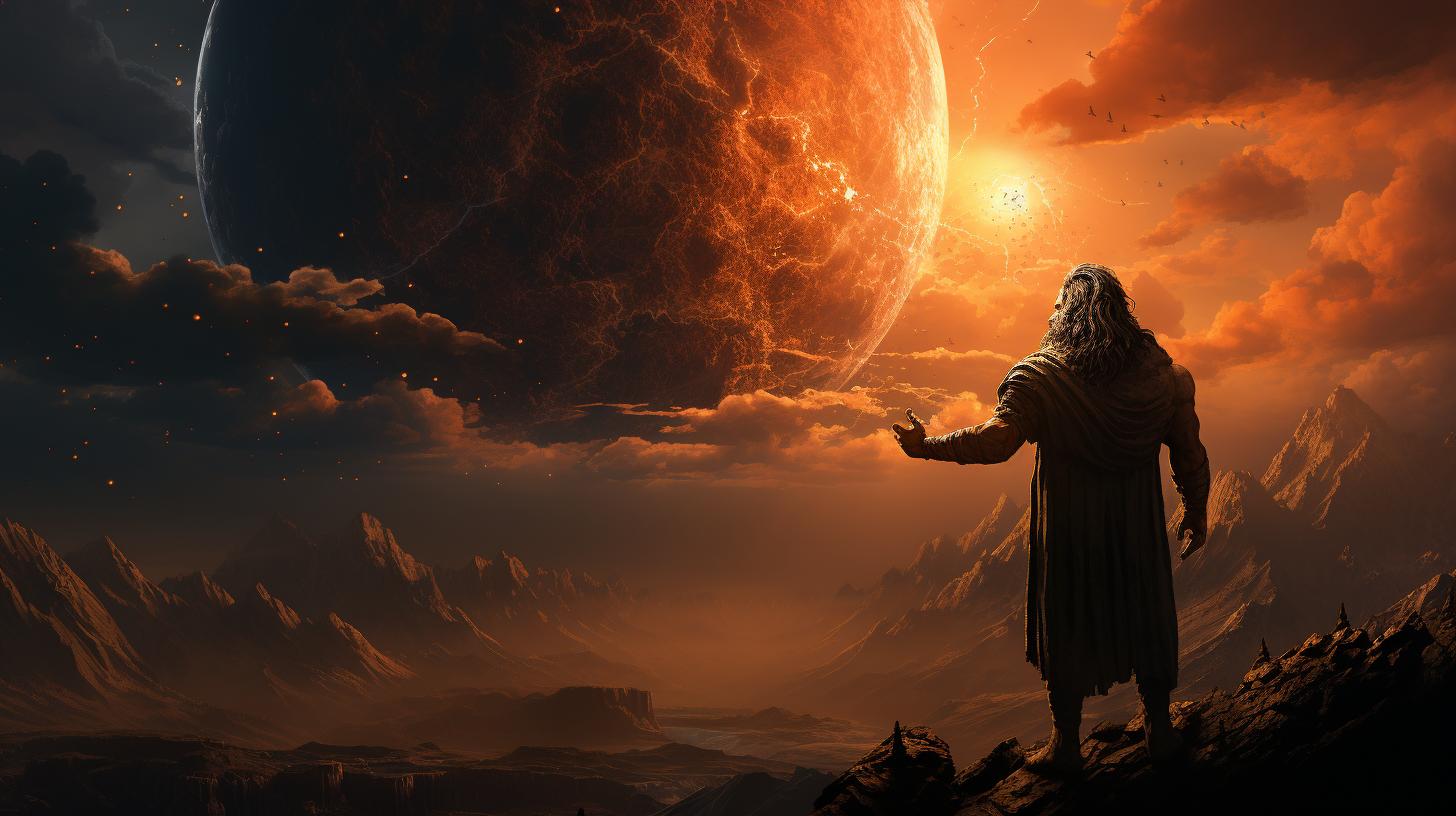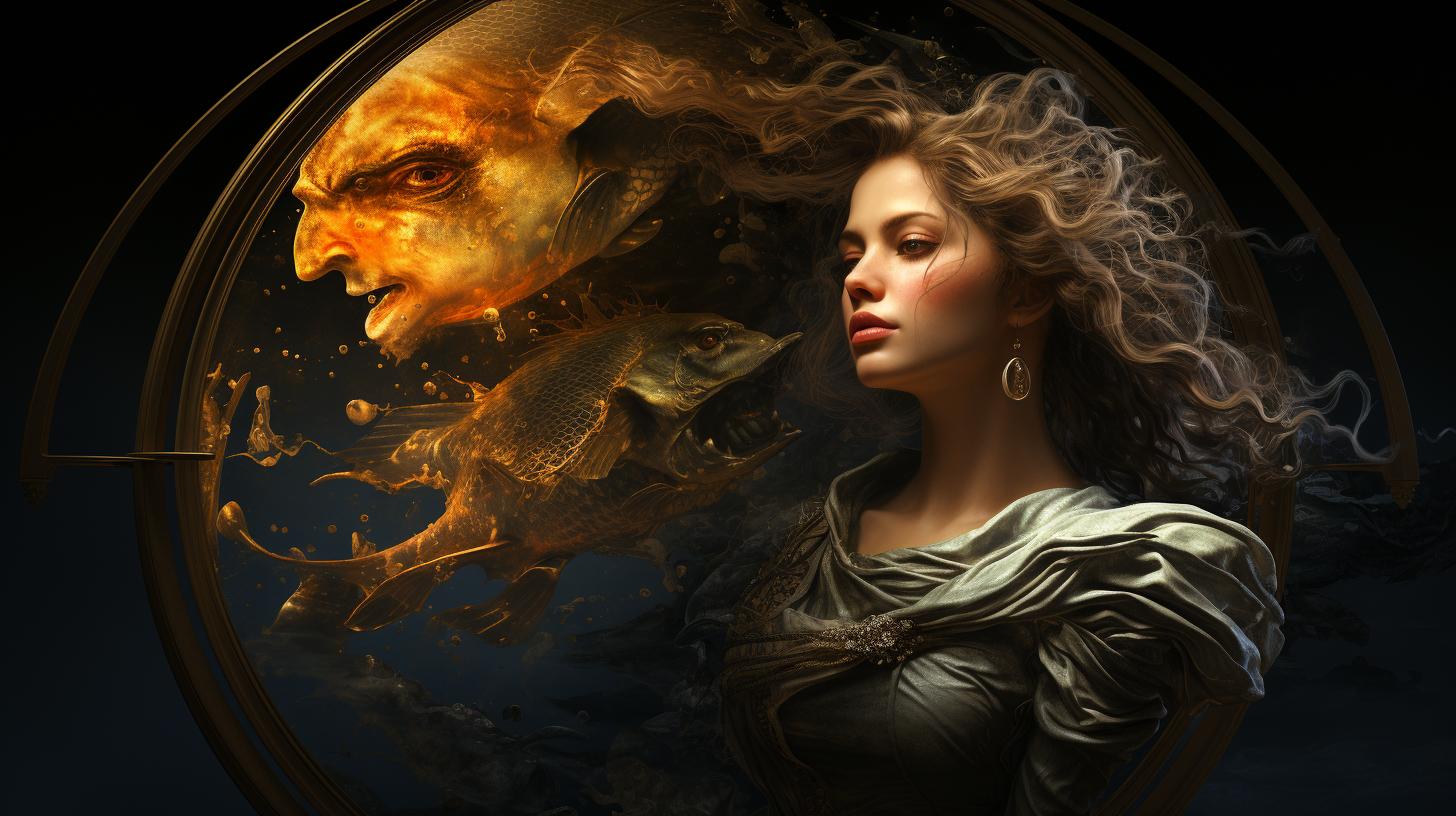Helios: The Majestic God of the Sun Revealed
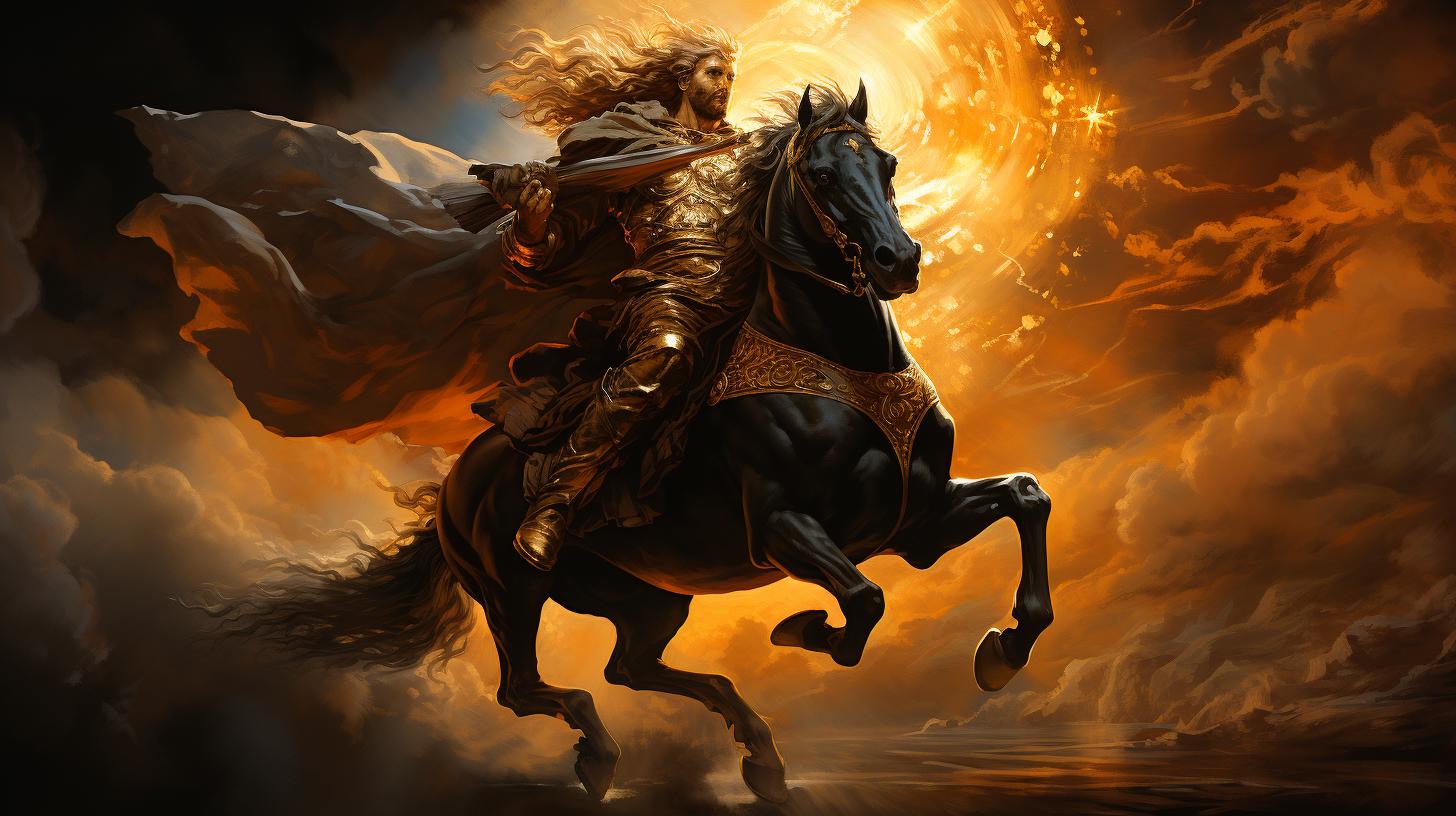
Helios, the god of the sun, is a prominent figure in Greek mythology. He is known for his role as the driver of the sun chariot, traversing the sky each day.
One of the notable tales involving Helios is the story of his son, Phaethon, who attempted to control the sun chariot but tragically failed, causing chaos on Earth. Helios was worshipped and revered, particularly in the island of Rhodes, and his influence expanded as he became associated with other deities.
During the Roman Empire, he was even worshipped as the invincible sun itself. The significance of Helios and his mythology can be explored in various aspects, from his family lineage to his portrayal in ancient Greek literature and art.
Mythology
In Greek mythology, the captivating tale of Helios, the god of the sun, is an intriguing and timeless story. It revolves around the ambition of Helios’ son, Phaethon, to drive his father’s majestic sun chariot for a day.
This desire led to disastrous consequences, as Phaethon lost control of the chariot, causing chaos and destruction on Earth. The myth of Phaethon’s ill-fated adventure serves as an explanation for the existence of uninhabitable lands and the dark complexion of certain peoples.
The genealogy of Helios reveals his illustrious lineage. As the son of the oceánide Clymene and the sun god Helios, Phaethon inherited his father’s divine qualities. Clymene, a nymph and mortal woman, played a crucial role in Phaethon’s birth, serving as a connection between the mortal and immortal realms.
Helios’ role as a father is evident in his relationship with Phaethon. Although he warned his son about the dangers of driving the sun chariot, his paternal love couldn’t dissuade Phaethon from his reckless ambition.
This emphasizes Helios’ caring nature and highlights the consequences of defying the gods’ wisdom and guidance.
Helios is not only associated with the sun but also shares connections with other fire and light deities. He is often equated with Apollo, the god of the sun, light, and music.
This association demonstrates the overlapping domains of these powerful gods and their influence on ancient Greek culture and belief systems.
Worship of Helios was particularly prominent on the island of Rhodes, where he held a special place in the hearts of the islanders. As his worship spread, Helios became identified with other deities, indicating the influence and adaptability of his cult.
During the Roman Empire, Helios was even revered as Sol Invictus, the invincible sun, showcasing the assimilation and syncretism of deities within different cultures.
Phaethon’s Ambition
Phaethon, the son of Clymene and Helios, had an overwhelming desire to prove himself by driving his father’s majestic sun chariot across the sky. He longed for the opportunity to control the reins and experience the power and glory that came with guiding the blazing sun.
Driven by youthful enthusiasm and ambition, Phaethon disregarded the warnings of both his mother and Helios himself. They cautioned him about the immense responsibility and danger involved in handling the sun chariot.
But Phaethon remained resolute and unwavering in his pursuit of this audacious task.
Phaethon’s ambition stemmed from a deep yearning to prove his divine lineage, to show the world that he was worthy of his father’s favor and recognition. He believed that successfully completing this seemingly impossible feat would elevate him to the status of a true hero and immortalize his name in the annals of Greek mythology.
- Driven by ambition and desire to prove himself worthy
- Ignoring warnings from his mother and Helios
- Yearning to prove his divine lineage
Phaethon’s Disaster
Phaethon, driven by his ambitious desire to prove himself, insisted on taking control of his father Helios’ sun chariot for a day. Despite the warnings and concerns expressed by those around him, Phaethon remained steadfast in his decision.
However, his lack of experience and inability to handle the powerful chariot resulted in a catastrophic disaster.
As Phaethon ascended into the sky, he struggled to maintain control of the reins, causing the celestial horses to veer off course. The sun chariot embarked on a perilous path, bringing havoc and destruction to the Earth below.
The once pristine skies turned dark, crops withered, rivers dried up, and oceans raged in turmoil.
Witnessing the devastation caused by his son’s reckless actions, Zeus, the king of gods, intervened. In order to protect the world from further harm, Zeus wielded his thunderbolt and struck Phaethon down from the sky, ending the disastrous chaos.
The lifeless body of Phaethon fell into the river, forever remembered as a cautionary tale of the dangers that come with reckless ambition.
Zeus’ Punishment
After Phaethon’s disastrous attempt to guide his father’s sun chariot, Zeus, the king of the gods, intervened to restore order. In his anger, Zeus unleashed a thunderbolt, striking Phaethon and causing his lifeless body to fall from the chariot.
Zeus’ punishment extended beyond Phaethon himself. The Earth suffered from the consequences of Phaethon’s reckless ride. The scorching heat scorched the land, drying up rivers and causing widespread devastation. The balance of nature was disrupted, and chaos reigned.
Realizing the magnitude of the disaster, Zeus took action to rectify the situation. He commanded the mighty river Eridanos to cleanse the Earth by flowing abundantly, extinguishing the fires and restoring fertility to the scorched land.
This devastating event served as a lesson to all, emphasizing the importance of respecting the power of the gods. It also explained the existence of uninhabitable lands and the darker complexion of certain peoples, as the sun’s intense exposure caused such effects.
From this point forward, the story of Phaethon’s ill-fated quest and Zeus’ punishment remains a cautionary tale, serving as a reminder of the consequences that can arise from arrogance and disobedience.
Genealogy
Helios, as the Greek god of the sun, has a significant place in ancient Greek mythology. In terms of his genealogy, Helios is typically described as the son of the Titans Hyperion and Theia.
Hyperion, whose name means “the high one,” represents light, while Theia, meaning “divine goddess,” symbolizes brightness and clarity. Together, they beget Helios, the personification of the sun.
Helios himself is the father of several notable offspring.
One of his sons is Phaethon, whose ill-fated adventure in driving the sun chariot led to disastrous consequences. Phaethon’s mother is Clymene, an oceánide or water nymph. The lineage of Helios extends even further, as he is also associated with other deities in Greek mythology.
Helios’ grandparentage includes the Titans Titans Ouranos and Gaia, who represent the sky and the earth, respectively. Moreover, as part of the second generation of Titans in Greek mythology, Helios is a descendant of the primordial deities, including Nyx (goddess of the night) and Erebus (personification of darkness).
Considering these familial connections, Helios occupies a prominent position within the intricate tapestry of Greek mythology. Through his lineage, he embodies the power and significance associated with the radiant sun.
Helios’ Lineage
Helios, the god of the sun, is part of a divine lineage with significant ties to other powerful deities. According to Greek mythology, Helios is the son of the titan Hyperion and the titaness Theia.
Hyperion and Theia are known as the parents of several celestial gods, with Helios being one of the most prominent figures among them.
As the brother of Selene, the goddess of the moon, and Eos, the goddess of the dawn, Helios completes the celestial triumvirate representing the three major aspects of the day: sunrise, daytime, and sunset.
This lineage establishes Helios as a key player in the divine order of the cosmos, responsible for the diurnal cycle that governs Earth.
Helios is also connected to other influential deities through his family connections.
His nephews are none other than the gods Apollo and Artemis, children of his sister Leto. Apollo, who presides over the arts, music, and prophecy, shares a strong association with Helios due to their shared dominion over light and solar power.
Helios’ lineage highlights his supreme position as a celestial deity and his familial ties to other gods who play essential roles in Greek mythology. These connections further enhance his significance and influence within the pantheon of Greek gods.
Phaethon’s Birth
Phaethon, the ill-fated son of Helios, was born into a divine lineage that traced back to the Titan, Hyperion. As the product of Helios’ union with the ocean nymph Clymene, Phaethon possessed a unique heritage.
The birth of Phaethon was a momentous occasion, as his arrival marked the presence of a future charioteer of the sun. This significant event was celebrated by the gods, who recognized the potential power and responsibility that Phaethon would inherit from his father.
Clymene, a loving and nurturing figure, delighted in the birth of her son. She raised Phaethon with care, instilling in him both a sense of pride in his divine lineage and a curiosity about his father’s remarkable role as the sun god.
Helios, as a father, took pride in his son’s existence and devoted attention to imparting knowledge about the celestial realm. He regaled Phaethon with tales of his daily journey across the sky, the magnificence of the sun chariot, and the fiery steeds that pulled it.
The birth of Phaethon not only marked the continuation of Helios’ lineage but also raised hopes for the future. It was clear that Phaethon possessed a potential destiny that would connect him intimately with the workings of the celestial realm, just like his father before him.
Clymene, Mother of Phaethon
One integral figure in the mythological tale of Phaethon is Clymene, the mother of Phaethon and a nymph known as an oceánide. Clymene was wedded to the mighty Helios, the sun god, and together they were blessed with the birth of their son Phaethon.
Clymene, often depicted as a graceful and radiant nymph, played a significant role in the story as a mother figure. Her status as an oceánide nymph connected her intrinsically to the water element, reflecting the importance of the sun’s vital role in nourishing all life on Earth.
Through her lineage, Clymene passed on the divine blood of Helios to Phaethon, making him a demi-god of tremendous potential.
- As the mother of Phaethon, Clymene undoubtedly held a deep love and concern for her son.It was her duty to guide and protect him as he navigated the challenges of fulfilling his ambition to drive the sun chariot.
- Clymene’s role as a mother also adds a touch of humanity to the myth, showcasing the complex emotions and dilemmas faced by mortal parents in raising their offspring.
- Her relationship with Helios is an essential aspect of the tale, highlighting the union between a mortal and a deity, and the intricate dynamics that ensued within their divine family.
Through the role of Clymene, the story of Phaethon and Helios takes on a familial dimension, intertwining mortal and immortal realms, and exploring the consequences of ambitious pursuits.
Clymene’s presence underscores the complexities of parenthood and the impacts it can have on mythological narratives.
Helios’ Role as Father
Helios played an important role as a father in Greek mythology, particularly in relation to his son Phaethon. As the god of the sun, Helios had a close connection with the mortal world, and his offspring often inherited divine qualities.
Phaethon, born to Helios and the oceánide Clymene, had an ambitious desire to drive his father’s sun chariot for a day. Despite the warnings, Phaethon persisted, and Helios reluctantly agreed to fulfill his son’s wish.
This decision showcases Helios’ paternal love and willingness to grant his child’s desires.
Helios’ trust in Phaethon, however, proved to be a tragic mistake. As Phaethon took hold of the fiery reins, he soon lost control of the sun chariot, causing havoc on Earth.
Seeing the chaos unfold, Zeus, the chief of the gods, had no choice but to intervene.
Zeus, recognizing the danger Phaethon posed, hurled a thunderbolt at the young demigod, ultimately ending his life.
This heartbreaking event highlights Helios’ role as a father who had to endure the loss of his son due to his own misguided decision.
Helios’ involvement as a father in this myth portrays both the complexities of divine parent-child relationships and the consequences of unchecked ambition.
The story serves as a cautionary tale, reminding us of the perils that can arise when children seek to emulate their divine parents without possessing their powers and wisdom.
Helios and Other Gods
Helios, the mighty Greek god of the sun, held a significant place among the pantheon of deities.
His associations extended beyond the realm of the sun, as he was linked to various other gods, particularly those connected to fire and light.
One of the most notable associations was with Apollo, the god of music, poetry, and the sun.
Helios and Apollo shared many similarities, such as their radiant appearance and their roles as drivers of chariots. Although they were considered distinct entities, they often became intertwined in mythology and religious practices.
In addition to Apollo, Helios had familial connections with several other deities. As the son of the Titans Hyperion and Theia, he was a sibling to Selene, the goddess of the moon, and Eos, the goddess of the dawn.
These family ties cemented his status within the divine hierarchy.
Furthermore, Helios was often equated with other fire and light-related gods, such as Hephaestus, the god of blacksmiths and craftsmanship, and Prometheus, the bringer of fire to humanity.
These associations highlighted the essence of Helios as a force of illumination and warmth.
The reach of Helios’ influence extended even further under the Roman Empire. The worship of Helios merged with the cult of Sol Invictus, the unconquered sun.
This syncretism solidified his standing as a central figure in solar worship.
Overall, Helios, with his connections to Apollo, his family lineage, and his associations with other fire and light gods, played a crucial role in the intricate tapestry of Greek mythology and religious belief.
Helios’ Associations with Fire and Light
Helios, the mighty god of the sun, is closely linked to the elemental forces of fire and light. In Greek mythology, he is often depicted as a radiant figure, emanating intense heat and brilliance.
As the personification of the sun, Helios represents the transformative power of fire and the illuminating qualities of light.
The association between Helios and fire stems from his role as the charioteer of the sun.
As he drives the sun chariot across the sky, his presence ignites the heavens, bringing light and warmth to the world below. The chariot itself is said to be forged from celestial flames, symbolizing Helios’ control over these fiery energies.
Furthermore, Helios’ association with light extends beyond mere illumination. His radiance is seen as a metaphor for enlightenment and divine knowledge. The rays that emanate from his face and body are believed to reveal hidden truths and offer clarity to mortals.
In this sense, Helios embodies the power of illumination, guiding humanity towards wisdom and understanding.
Helios and Apollo
In Greek mythology, another prominent deity associated with fire and light is Apollo, the god of music, poetry, and prophecy. Helios is often identified with Apollo as they share similar attributes, with both representing the sun and its transformative qualities.
Apollo, a multidimensional deity who encompasses various aspects of life, is regarded as a manifestation of Helios in different forms.
Helios’ influence on Apollo can be seen through their shared association with fire.
Apollo’s epithets, such as “Phoebus” or “Phoebus Apollo,” derive from the Greek word for “radiant” or “shining.” These titles highlight Apollo’s connection to the solar radiance and reinforce his link to Helios.
Helios’ Family Connections
Within the realm of Greek mythology, Helios is part of a divine family tree that includes several prominent gods. He is often portrayed as the son of Hyperion and Theia, making him the sibling of the moon goddess Selene and the dawn goddess Eos. This familial connection strengthens Helios’ association with the celestial bodies and the luminous forces they represent.
Additionally, Helios’ role as the father of Phaethon further emphasizes his position among the divine pantheon. Phaethon’s ill-fated attempt to drive the sun chariot underscores the immense power that Helios possesses, as well as the potential dangers associated with fire and light.
In conclusion, Helios’ associations with fire and light are central to his mythological significance. He symbolizes the transformative energy of fire, the illuminating power of light, and the inherent wisdom and enlightenment that these forces offer.
His identification with the sun and his familial connections within the divine hierarchy further cement his important role in Greek mythology and the cultural understanding of the sun’s celestial influence.
Helios and Apollo
Helios, the Greek god of the sun, shares a significant connection with Apollo, another prominent deity in Greek mythology. Both Helios and Apollo are associated with the sun and light, although their roles differ slightly.
Apollo, the son of Zeus and Leto, is often depicted as the god of music, poetry, prophecy, and healing. However, he also possesses solar qualities, representing the sun as a source of illumination and inspiration.
In some myths, Helios and Apollo are described as distinct entities, with Helios being responsible for driving the sun chariot across the sky, while Apollo symbolizes the sun’s creative and intellectual aspects.
Apollo’s association with the sun highlights his role as an enlightened and radiant god.
However, there are instances where Helios and Apollo are identified as interchangeable or closely related.
In these narratives, Helios may be regarded as an aspect or manifestation of Apollo, emphasizing the sun god’s multifaceted nature.
Regardless of the exact relationship between Helios and Apollo, their combined influence represents the power and significance of the sun in Greek mythology.
It reflects how the ancient Greeks recognized both the physical and metaphorical importance of the sun in their lives, attributing various divine qualities to these two interconnected gods.
Helios’ Family Connections
Helios, as the Greek god of the sun, is connected to various other gods and goddesses through his familial relationships.
One of the most significant connections is his lineage as the son of the Titans Hyperion and Theia. Hyperion, associated with the light, and Theia, associated with shining, bestow upon Helios his radiant and majestic qualities.
Helios himself is a father figure, and his most famous son is Phaethon, who sought to drive his father’s sun chariot. Phaethon’s ambition and the disastrous consequences that followed are central to the mythology surrounding Helios.
Despite Phaethon’s tragic end, it highlights Helios’ role as a father and the challenges that come with wielding such power.
Additionally, Helios is closely linked to other gods associated with fire and light.
He shares a connection with Apollo, the Greek god of music and poetry, as both are often depicted driving their respective chariots across the sky. This association further strengthens Helios’ significance and influence within the Greek pantheon.
Furthermore, Helios’ family connections extend beyond his immediate lineage. He is often identified with other solar deities, such as Sol Invictus, who was worshipped during the Roman Empire. This identification reflects the widespread cultural and religious influence of Helios, demonstrating his connection to other gods across different civilizations.
Overall, Helios’ family connections illuminate his role as a central figure in Greek mythology, showcasing the interplay between familial relationships and his associations with gods of fire and light. These connections deepen our understanding of Helios’ importance and his place within the pantheon of gods worshipped in ancient Greece.
Helios as the Sun God
Helios, the mighty god of the sun, holds a central role in Greek mythology as the deity responsible for the daily journey of the sun across the sky. He is depicted as a radiant and powerful figure, often portrayed with a shining halo and golden rays emanating from his body.
The sun chariot that he drives symbolizes his divine power and control over the celestial body that brings light and warmth to the world.
As the sun god, Helios is closely associated with fire and light, representing the life-giving and illuminating aspects of the sun.
He shares a deep connection with his son, the god Apollo, who also embodies these qualities and is often depicted as a youthful and radiant figure, much like his father.
Helios’ divine lineage traces back to the Titans, with his parents being the Titan Hyperion and the Titaness Theia. Through this lineage, he is connected to other notable gods, such as his siblings Selene, the moon goddess, and Eos, the goddess of dawn.
The daily journey of Helios in his sun chariot is a significant aspect of his role as the sun god. Riding across the sky from east to west, he illuminates the world and brings light to both gods and mortals.
The horses that pull his chariot, known as Phaethon, Aethon, Pyrois, and Phlegon, are associated with fire and embody the fiery nature of the sun itself.
The absence or presence of Helios has profound effects on the world.
When he is absent during the night, his sister Selene takes over and illuminates the world with her gentle moonlight. However, when Helios is present during the day, his radiant light bathes the earth, allowing plants to grow and providing warmth and life to all living beings.
Throughout the ancient world, Helios was widely worshipped and revered. The island of Rhodes held a particular devotion to Helios, and his worship spread across various regions, as he became identified with other sun deities in different cultures.
During the Roman Empire, the cult of Helios merged with the worship of the Sol Invictus, the unconquered sun.
The depiction of Helios as the sun god can be seen in various forms of ancient Greek literature and art.
His presence is often portrayed in sculptures, paintings, and mosaics, showcasing his celestial radiance and divine power. The stories and legends surrounding Helios continue to captivate and intrigue, offering a glimpse into the ancient belief systems and the reverence for the sun as a vital force in the world.
Helios’ Daily Journey
Every day, Helios embarks on a majestic journey across the sky, guiding the chariot of the sun. As the first light of dawn breaks, Helios sets forth in his golden chariot, pulled by magnificent fire-breathing horses.
With each passing moment, he ascends higher, illuminating the world with his radiant glow.
The path of Helios is not without its challenges. As he reaches the zenith, the sun shines brightest, casting its warm and life-giving rays upon the Earth below.
The world basks in the glorious light as Helios oversees all from above.
But as the hours pass, Helios slowly descends toward the horizon. The sun’s intensity wanes, giving way to the gentle hues of twilight.
The journey nears its end, and Helios prepares to bid farewell to the day.
As dusk approaches, golden hues ignite the sky, painting a breathtaking spectacle before nightfall. The fiery chariot glides upon the western horizon, casting long shadows upon the land.
The world transitions into darkness as Helios concludes his daily expedition.
Thus, Helios’ daily journey signifies the cycle of day and night, as well as the eternal rhythm of life. His radiant presence during the day brings light, warmth, and vitality, while his departure marks the beginning of a tranquil and mysterious night.
The Chariot of the Sun
The chariot of the sun was the majestic vehicle driven by Helios as he traversed the sky, illuminating the world with his radiant light. Drawn by fiery steeds, this magnificent chariot symbolized the power and glory of Helios as the god of the sun.
According to ancient Greek mythology, the chariot was said to be crafted by Hephaestus, the god of blacksmiths and artisans. It was made of gleaming gold, adorned with intricate carvings and embellishments that reflected the splendor and majesty of the sun.
Every day, at the break of dawn, Helios would climb into his chariot, taking hold of the reins tightly. As he guided the horses across the sky, the sun would rise, casting its warm, golden light upon the earth.
The chariot’s swift movements signaled the passage of time and marked the beginning of the day.
However, controlling the chariot of the sun was no easy task. The chariot was known to be exceedingly difficult to handle, requiring immense strength, skill, and focus.
Helios, with his divine powers, was capable of controlling the chariot, ensuring its steady course across the heavens.
Legend has it that when Helios’ son, Phaethon, attempted to take control of the chariot without his father’s permission, disaster struck.
Unaccustomed to the immense power of the sun chariot, Phaethon lost control, veering off course and wreaking havoc upon the earth. The catastrophic events that unfolded served as a cautionary tale about the dangers of recklessness and the importance of divine authority.
The chariot of the sun not only represented the physical movement of the sun across the sky but also held symbolic significance. It embodied the cycle of life, representing the daily renewal and rebirth as the sun rose, bringing light and warmth to the world.
Through ancient Greek literature and art, the image of the chariot of the sun has been immortalized. It serves as a powerful symbol of Helios’ dominion over the sun, highlighting his role as the bringer of light and life to the world.
Horses of Helios
One of the most captivating aspects of Helios, the Greek god of the sun, is his majestic chariot that traverses the sky. This magnificent chariot is pulled by a team of fiery horses that symbolize the power and intensity of the sun’s rays.
The horses of Helios represent the untameable energy and vitality that he harnesses to illuminate the world. These divine steeds are said to possess a radiant golden coat that glistens with celestial light as they gallop across the heavens, leaving a trail of brilliance in their wake.
Legend has it that these horses are not mere mortal creatures but divine beings themselves, endowed with incredible strength and grace. The names of these mythical horses are often mentioned in various ancient texts, including “Pyrois” (the fire horse), “Eos” (the dawn horse), “Aethon” (the burning horse), and “Phlegon” (the blazing horse).
- Pyrois: Known for its fiery mane and tail, Pyrois embodies the scorching heat and intense energy of the sun.
- Eos: As the horse of dawn, Eos represents the vibrant colors that paint the sky during the early morning hours.
- Aethon: With its luminous glow, Aethon symbolizes the radiant light emitted by the sun.
- Phlegon: The fastest and brightest of them all, Phlegon embodies the dazzling brilliance of the midday sun.
Helios is often depicted standing proudly in his chariot, reins in hand, guiding these magnificent horses on their daily journey across the sky.
It is this symbolic representation that highlights the powerful connection between Helios and the sun, as he becomes the driving force behind the rotation of day and night.
Through the awe-inspiring horses of Helios, the ancient Greeks sought to convey the grandeur and magnificence of the sun and its radiant light.
These mythical equine beings serve as a reminder of the celestial power that Helios wields as the god of the sun, illuminating the world with his divine presence.
Effects of Helios’ Absence or Presence
The presence or absence of Helios, the mighty god of the sun, had significant effects on both nature and human life.
As the charioteer of the sun, Helios’s presence brought warmth, light, and vitality to the world. His absence, on the other hand, caused darkness, coldness, and a sense of gloom.
- Day and Night: Helios’ daily journey across the sky determined the cycle of day and night.When Helios was present, daylight illuminated the earth, providing visibility and energy for all living creatures. People could engage in various activities under the warmth of his radiance.
- Plant Life: Helios’ presence was vital for the growth and development of plants.His rays provided the crucial sunlight needed for photosynthesis, enabling plants to produce food and oxygen. The absence of Helios could result in stunted growth, withering of leaves, and a decline in agricultural productivity.
- Climate: The sun’s warmth, facilitated by Helios, influenced climate patterns.His rays determined the seasons, impacting temperature variations throughout the year. His presence during summer brought about a pleasant warmth, while his absence in winter led to colder temperatures.
- Human Activities: Helios’ presence significantly affected human activities.His light enabled outdoor work, leisure, and social gatherings. People could engage in farming, fishing, and various recreational activities during the day. His absence, however, limited such activities, forcing people to seek shelter or rely on artificial sources of light.
- Mood and Emotions: The presence of Helios had a positive impact on human mood and emotions.His warmth and light uplifted spirits and generated a sense of optimism and happiness. Conversely, his absence could evoke feelings of sadness, melancholy, and even depression.
In conclusion, the presence or absence of Helios, the god of the sun, had far-reaching effects on the natural world and human life.
His radiance brought light, warmth, and vitality, while his absence caused darkness, coldness, and a sense of gloom. The cyclical nature of Helios’ presence and the world’s dependence on the sun highlight the significance of this powerful deity in ancient Greek mythology.
Helios’ Worship and Cult
In ancient Greece, Helios was a highly revered deity, and his worship and cult practices played a significant role in various communities. One of the primary centers of Helios’ worship was the island of Rhodes, where a magnificent temple dedicated to him, known as the Colossus of Rhodes, stood as one of the Seven Wonders of the Ancient World.
The cult of Helios in Rhodes was closely intertwined with the island’s identity and culture. The Rhodians believed that their city was founded by Helios himself and considered him their primary protector.
The strong association between Helios and Rhodes is evident in the numerous inscriptions and dedicatory offerings found in ancient sanctuaries and religious sites on the island.
As time went on, the cult of Helios expanded beyond Rhodes, and he became more widely worshipped throughout Greece and neighboring regions.
Helios’ worship often merged with that of other solar deities, such as Apollo. This syncretism led to the development of diverse cult rituals and practices, as well as the identification of certain attributes and symbolism with Helios.
Under the Roman Empire, Helios’ cult reached its zenith as he became equated with the Roman deity Sol Invictus, the unconquerable sun. This assimilation contributed to the spread of Helios’ worship across the Roman territories and the establishment of grand temples dedicated to him in various cities.
Devotees of Helios honored him through prayers, offerings, and participation in religious festivals. These rituals aimed to seek his favor, protection, and blessings, particularly in relation to sunlight, warmth, and agricultural prosperity.
The importance of Helios’ worship extended beyond individual spiritual devotion, and his influence permeated various aspects of ancient Greek society.
Overall, the worship and cult of Helios showcased the profound veneration and reverence that ancient Greeks had for the sun god, attributing to him immense power and significance in their daily lives and culture.
Worship of Helios in Rhodes
One of the most notable places where Helios was revered and worshipped was the beautiful island of Rhodes. The inhabitants of Rhodes held a special devotion to Helios, considering him as their patron god.
They believed that Helios protected and blessed their island with his radiant light and warmth.
The Rhodians built an impressive sanctuary dedicated to Helios, known as the Colossus of Rhodes. This colossal statue, one of the Seven Wonders of the Ancient World, depicted Helios standing tall, holding a torch in one hand and a celestial sphere in the other.
It was not only a symbol of their religious devotion but also represented their strong maritime and commercial power.
The annual festival of Helios, known as the Heliaia, was celebrated with great enthusiasm in Rhodes.
During this festival, the Rhodians organized processions, athletic contests, and musical performances to honor their beloved god. The festivities included lively dances and feasts, where the people offered prayers and sacrifices to appease Helios and demonstrate their reverence.
The cult of Helios in Rhodes gradually extended beyond the island and gained popularity in other cities and regions as well. As it evolved, Helios became associated with other deities, such as Apollo, who was also connected to the sun and light.
This syncretism allowed for a broader worship of Helios, further strengthening his divine presence in the Greek pantheon.
- Devotion and reverence of Helios in Rhodes
- Construction of the Colossus of Rhodes
- Significance of the Colossus in representing their religious beliefs and power
- Annual festival of Helios – Heliaia
- Processions, athletic contests, and musical performances during the festival
- Expanding cult of Helios beyond Rhodes
- Association of Helios with other deities like Apollo
Identification of Helios with Other Deities
Helios, the radiant god of the sun, holds a significant place in Greek mythology and is often associated with other powerful deities.
His divine attributes and symbolic representation of sunlight and warmth have led to his identification with various gods related to fire and light.
One notable deity Helios is often connected with is Apollo, the god of music, poetry, and healing.
Both Helios and Apollo share similar characteristics, such as their association with the sun and their role as givers of life. In some versions of the myths, Helios is even considered as a form of Apollo.
Furthermore, Helios reveals familial connections with other gods.
He is often identified as the son of Hyperion and brother to Selene, the goddess of the moon, and Eos, the goddess of the dawn. This familial bond intertwines his divine essence with the celestial bodies and reinforces his position as a deity of immense power and influence.
Another significant identification is Helios with Hephaestus, the god of blacksmiths, fire, and craftsmanship. This connection is primarily due to their association with fire. Helios’ daily journey across the sky parallels the forging of metal in a fiery furnace, highlighting the transformative properties both gods possess.
The identification of Helios with other deities not only enriches the understanding of Greek mythology, but it also emphasizes the multifaceted nature of this sun god. His presence intertwines with various aspects of life, from the warmth of the sun to the creative power of fire, leaving an indelible mark on the divine pantheon.
Helios as Sol Invictus under Roman Empire
During the Roman Empire, the worship of Helios expanded further, and he became intimately associated with the sun itself, being revered as the invincible god of the sun, known as Sol Invictus.
Under Roman rule, the sun became a prominent symbol of power and divine authority, and the cult of Sol Invictus gained significant popularity. The Romans, impressed by the radiant glory and life-giving energy of the sun, embraced the worship of Helios in their pantheon of deities.
The cult of Sol Invictus became especially prominent in the third century AD, during the reign of Emperor Aurelian. He declared Sol Invictus as the official sun god of the Roman Empire, establishing a centralized cult that further solidified Helios’ association with the sun.
Many Roman emperors identified themselves with Sol Invictus, using the sun’s divine symbolism to legitimize their power and portray themselves as invincible rulers. The sun’s life-giving warmth and light were seen as analogous to the emperor’s authority and prosperity.
Temples dedicated to Sol Invictus were erected throughout the empire, with one of the most famous being the Sol Invictus Temple in Rome. Festivals and celebrations honoring Helios as the unconquerable sun were held, particularly during the annual Sol Invictus feast on December 25th, coinciding with the winter solstice.
The cult of Sol Invictus continued to flourish even after the rise of Christianity, and some scholars believe that elements of Sol Invictus worship influenced the development of Christmas celebrations in Christian traditions.
In conclusion, the inclusion of Helios as Sol Invictus within the Roman pantheon highlighted the significance and power attributed to the sun. The cult’s popularity and its connection to imperial authority demonstrated the enduring influence of Helios as the supreme god of the sun in the Roman Empire.
See also
While Helios god of sun holds a prominent place in Greek mythology, there are various other gods and figures that play significant roles in this rich mythological tradition. Exploring these related deities and characters can deepen our understanding of the broader mythological context.
Consider the following:
- Other Gods and Figures in Greek Mythology: In addition to Helios, there are numerous other gods and mythical beings that shape the Greek pantheon. From Zeus, the king of gods, to Aphrodite, the goddess of love, each deity brings their own unique attributes and stories to the table.
- Helios in Ancient Greek Literature: Helios’ presence can be found in many ancient Greek texts, both within the realm of mythology and beyond.His appearance in famous works such as Homer’s “Iliad” and Ovid’s “Metamorphoses” showcases the enduring influence of this mighty sun god.
- Helios in Art and Iconography: The captivating tales of Helios have inspired countless artists throughout history.From ancient sculptures and pottery to Renaissance paintings, discover the visual representations of Helios and his chariot that capture his power and radiance.
These additional avenues of exploration allow us to delve deeper into the captivating world of Greek mythology and shed further light on the splendor and significance of Helios god of sun.
– Other Gods and Figures in Greek Mythology
In addition to Helios, Greek mythology is rich with a multitude of gods and figures who play significant roles in various narratives. These deities and individuals contribute to the intricate tapestry of Greek mythology, adding depth and complexity to the stories passed down through generations.
The Olympian Gods
- Zeus: The king of the gods and ruler of Mount Olympus.
- Hera: The queen of the gods and the goddess of marriage and childbirth.
- Poseidon: The god of the sea, earthquakes, and horses.
- Hades: The god of the underworld and ruler of the dead.
- Athena: The goddess of wisdom, strategic warfare, and crafts.
- Apollo: The god of light, music, prophecy, and healing.
- Artemis: The goddess of the hunt, wild animals, and the moon.
- Aphrodite: The goddess of love, beauty, and desire.
- Hermes: The messenger of the gods, associated with travel, communication, and commerce.
- Ares: The god of war and violence.
- Hephaestus: The god of fire, blacksmiths, and craftsmen.
- Dionysus: The god of wine, parties, and ecstasy.
- Demeter: The goddess of agriculture, fertility, and the harvest.
Other Prominent Figures
- Prometheus: A Titan who stole fire from the gods to benefit humanity.
- Pandora: The first woman created by the gods, bringing both blessings and curses to humanity.
- Persephone: The goddess of spring and queen of the underworld, associated with the cycle of seasons.
- Hercules: A mighty hero who performed twelve labors to atone for his sins.
- Medusa: A Gorgon with snakes for hair, whose gaze could turn people to stone.
- Odysseus: The hero of the epic poem “The Odyssey,” known for his cunning and intelligence.
- Achilles: The greatest warrior of the Trojan War, whose only weakness was his heel.
- Orpheus: A legendary musician and poet who could charm even the gods with his skill.
These are just a few examples of the diverse range of gods and figures found in Greek mythology.
Each character brings their own unique attributes, stories, and contributions to the mythological landscape, captivating and inspiring generations for centuries.
Helios in Ancient Greek Literature
Helios, the revered god of the sun in Ancient Greek mythology, played a significant role in various literary works of the time. Many poets and playwrights incorporated Helios and his chariot into their stories, emphasizing his power and divine essence.
In Homer’s Iliad, Helios is depicted as a witness to the events of the Trojan War. He watches over the battlefield, illuminating the earth with his radiant light, and his presence often signifies the dawning of a new day or the beginning of a significant event.
In the tragic play Phaethon by Euripides, the ill-fated son of Helios takes center stage. The play explores Phaethon’s ambition to drive his father’s sun chariot, his disastrous attempt, and the subsequent punishment inflicted upon him by Zeus. This tragic tale serves as a cautionary lesson about the dangers of impulsive actions and hubris.
Helios also makes appearances in other Greek myths and epics. In Apollonius of Rhodes’ Argonautica, Helios aids the heroes in their quest for the Golden Fleece by providing them with vital information.
His omniscience and ability to witness events from his vantage point in the sky make him an invaluable ally.
Moreover, Helios is often praised for his role as the source of light and warmth.
Many poets invoke his name to depict the beauty of sunrises and sunsets, attributing the colors and brilliance to the god himself. Helios’ presence in literature symbolizes the life-giving power of the sun and its influence on the natural world.
Helios in Art and Iconography
Helios, the god of the sun, played a significant role in ancient Greek art and iconography. Depictions of Helios can be found in various forms, showcasing his importance in Greek mythology and religion.
One common representation of Helios is as a charioteer riding his sun chariot across the sky. These artworks often show Helios with rays emanating from his head, symbolizing the radiance and power of the sun.
The intricate details in these portrayals highlight the significance of Helios in sustaining life and bringing light to the world.
Helios is frequently depicted alongside his celestial horses, representing the magnificent and fiery nature of the sun.
These horses are usually shown with fiery manes and tails, capturing the dynamic energy associated with the sun’s movement across the heavens. The skillful craftsmanship in these artistic renderings exemplifies the admiration and reverence for Helios as the divine charioteer.
In addition to his role as the sun god, Helios is often assimilated with other deities, most notably Apollo. This association is seen in various artistic representations where Helios and Apollo are depicted together, emphasizing their shared attributes and domains.
These depictions establish a connection between the sun god and other aspects of Greek mythology and culture.
Artworks featuring Helios also provided insights into his lineage and family connections. Sometimes, Helios is portrayed with his family members, including his son Phaethon and his sisters, the Heliades.
These visual narratives capture the mythical tales associated with Helios and serve as a visual reminder of his divine lineage.
The art and iconography surrounding Helios reflect the Greek society’s fascination with the sun and its essential role in their lives.
Through intricate details and symbolism, these artistic representations convey the power, radiance, and celestial nature of Helios, further cementing his status as a revered deity.

